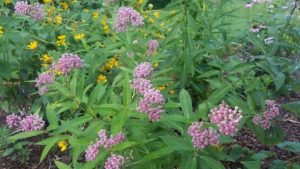Learn about the native Illinois milkweed
University of Illinois Extension Services — July 9, 2021
Swamp milkweed is one of two native milkweeds that prefer wetland habitats with full sun and moist, not wet, soil. Its small pink flowers are quite fragrant, smelling like cinnamon when it blooms. (Photo by Ryan Pankau/ courtesy of University of Illinois)
In recent years, milkweeds have gained attention from the public due to their exclusive relationship with the monarch butterfly.
“Many people are familiar with common milkweed,” says Ryan Pankau, University of Illinois Extension horticulture educator. “Before I knew the exact species name, I knew this plant was a milkweed and that it had milky sap.”
The common milkweed is a notoriously weedy species, growing wherever its light, fluffy seeds land. Any open sunny habitat will do from roadside ditches to abandoned fields, along woodland edges and railroad tracks.
While you may be familiar with the common variety, there are more than 20 milkweed species native to Illinois.
“The variety and adaptability in this plant family is really quite amazing,” says Pankau. “You can find milkweed thriving in nearly every environment throughout our state — wetlands, woodlands, open prairies, and even rocky glades.”
Although many of them are remarkably adaptable, five species of milkweed are currently listed as endangered in Illinois and one is considered federally threatened.
Swamp milkweed is one of two native milkweeds that prefer wetland habitats with full sun and moist, not wet, soil. Despite these very specific preferences, it occurs in nearly every county across Illinois. It often pops up in drier locations where it takes on a narrow form with wider leaves, which can make field identification challenging.
The adaptability and attractive appearance of swamp milkweed makes it a popular landscape plant. Its small pink flowers are quite fragrant, exuding a cinnamon scent when it blooms.
Butterfly milkweed is another ornamental extrovert among the milkweed family often found in landscape plantings.
“Many gardeners I’ve discussed this plant with over the years did not even realize it was actually a milkweed and for good reason,” says Pankau.
Butterfly milkweed has an alternate leaf arrangement and lacks the trademark milky sap. To add to the confusion, it is commonly referred to as ‘butterfly weed’ on plant tags and in common parlance. It has immaculate orange blooms, while most milkweed flowers are white or pink. It has long-lasting blooms, which appear first in early summer and often for a second time in late summer or early fall.
Whether you’re looking for an interesting and ecologically valuable plant to add to your landscape, or just want to observe and enjoy interesting plant species in nature, consider this under recognized Illinois native.
“There truly is a milkweed out there for everyone,” says Pankau.







